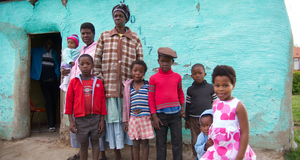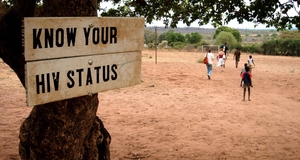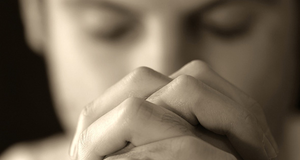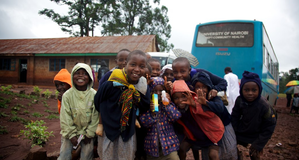Featured Article:Solving Health Issues in Ethiopia with ReligionThe EOC was also backed by humanitarian aid from the International Orthodox Christian Charities (IOCC) in 2004, when a $6 million project was inaugurated. Its target was the enhancing the capacity of the EOC to care for orphans with AIDS and to offer palliative and hospice care for people with AIDS. Thus, the project targeted the increase of “Hope Centers” for AIDS orphans from 13 to 200, and increasing the number of community-based hospice programs to 250. It was estimated that by 2006, 9,000 orphans and children will be provided with adult supervision, education, food, health care, and shelter. Like the program developed by the EOC in 2000, this project included a prevention program that stressed the importance of abstinence/faithfulness to one partner among youth between 15 and 24 years of age. This educational program included public rallies, peer counseling, posters, literature, musical productions, the distribution of t-shirts, but most importantly, the training of counselors who will teach people and other future trainers about the AIDS prevention. The project was implemented in 11 largest urban centers in the Southern Nationalities and Nation-People Region, as well as Oromiya and Tigray regions.29 A year later, in 2005, the EOC-DICAC developed its Strategic 4-year Plan. It is important to mention that the DICAC, although Orthodox at origin, does not discriminate on the base of religion, ethnicity, or gender.30 The Strategic Plan’s main goals are to contribute to a food secure society, to a society free of HIV/AIDS and other diseases, to a literate society, to gender equity, and to promote peace building and advocacy. In the case of HIV/AIDS, EOC established as its goals to create 80% in depth knowledge and 60% behavioral change in the community at large, to increase the quality of voluntary and testing services, to support the research on HIV/AIDS, and to train 200 sex workers into income generation groups.31 Aside from the Church community, the EOC-DICAC mobilized communities and community-based organizations, government partners, funding partners, NGOs, and public figures. In addition, the EOC-DICAC mobilized human, physical (vehicles, furniture, equipment, and buildings), and financial (internal and external funding, estimated at approximately $5,000,011.32This strategic plan should be seen in the context of other partnerships. One of these was sealed between the Church and the European Union Civil Society of Ethiopia in 2007, and targeted the implementation of a constituency building program, that would encourage the members of the community to come together and solve the problems in that community. Thus, the ultimate goal is to empower the community to be self-reliable. By training clergies and church and religious leaders in developmental programs, self-initiative resource mobilization, as well as in strategies to tackle issues such as HIV/AIDS, the program hopes to be able to transmit these helpful messages and self-reliability in terms of program implementation at the community level.33 Finally, a partnership between the EOC-DICAC and the Population Council let to a two-year project (2008-2010) that seeks to integrate HIV information in the teachings of the Church. The fact that there are 500,000 clergy that receive education and the Church’s schools, 6.5 million people that attend Sunday school each week, and that a majority of people attend first a religious school before any formal school makes EOC a perfect terrain for spreading information about HIV/AIDS and their prevention. Encouraging priests to talk to their parishioners about HIV prevention, reproductive health issues, and traditional practices such as early marriage and female genital mutilation could help not only in changing mentalities and behaviors in the community. Also, encouraging priests to reject requests of blessing early marriage could reduce the birth complications that arise in these young mothers. Moreover, information can be disseminated through the “Glossary of the Day-to-Day Teachings of the Church,” or “Lexicon,” which comprises of not only in spiritual guidance but also in secular messages. It is supposed to guide Christians in their daily life, earthly and spiritual, and reaches many, so that it is a great resource in spreading HIV and other health-related information.34 A presentation about the involvement of the EOC in the prevention of HIV/AIDS shows that multiple sexual partners, the abuse of alcohol, and untreated STIs determine the high incidence of HIV, and that the involvement of the EOC is crucial not only because it can mobilize its large network and resources that can reach even the most remote areas of Ethiopia to help, but also because it reinforces behaviors such as regular uptaking of VCT and societal acceptance of people infected with HIV. A huge number of volunteers aid the HIV prevention programs: 45,700 clergy, 2,060 Sunday school peer educators, 1,320 project advisors, and 420 C&S volunteers. These volunteers wok up to 40 hours/week, and a total of 33 million hours, and the value of their time is estimated at $8.2 million. In addition, the EOC HIV/AIDS programs help address negative social norms, silence and the stigma associated with having HIV/AIDS. Indeed its impact can be seen in the increased community support for people with HIV/AIDS and in the better implementation of income generation activities.35 Thus, it is clear that the role of the official religion, namely the Ethiopian Orthodox Church, in mediating the health issues that plague Ethiopia and the inappropriateness of the health system is crucial. Traditional Religious Beliefs Solving Ethiopia’s Health ProblemsEthnomedical beliefs can differ quite a lot from the regular biomedical ones. A central theme of the Traditional African Religions is the belief in magic, in the protection medicine. Magic requires prayers, spells, special objects and astrological-numerical knowledge, and can tap into the powers of a variety of spirits, such as the ones in the zar cult, the shatana etc. In line with syncretism, the spirits of the Church (e.g., saints), or of the enemies of the Church (ganel-demons) can be summoned, too. The latter can cause a variety of illnesses, including epilepsy and apoplexy. However, the essential point in traditional African religion’s approach to illness and healing is that they conceive the human being as a whole. Thus, one has to protect the physical health, while at the same time not disregarding one’s mental and spiritual health.36 Many times these ethnomedical beliefs are crucial to the prevention and cure of various maladies in places where these beliefs are respected by the community. They can actually have a sound basis and help the people afflicted by the disease or they can at least present a ground upon which the prevention and treatment programs could be made more accessible to the community. A study done in a Dongora Sidamo community, in south Ethiopia, heavily afflicted by malaria, showed that the people believed the maize pollen, dampness or drinking milk in the lowlands were responsible for malaria, and they pointed to the use of herbs and Western medicine as ways to treat it. Thus, health education would enhance the Sidamo’s grasp on how the disease works and how they can prevent it but only if presented in a culturally relevant context.37 A similar finding related to tuberculosis. The Sidama believe that excessive work, contagion and malnutrition as principal factors for tuberculosis, and as principal treatments, pointed to traditional remedies, including cautery, which has to be done by a traditional medical specialist.38 Health, in these traditional communities, is frequently defined as a state of equilibrium between physiological states, Nature, social harmony, and spiritual holiness.39 This is why, many people resort to traditional healers and magico-religious healing practices. The zar cult is one of the strains of traditional religions, involving the belief in spirit possession. A person (usually single women) is chosen to enter the cult by a zar, and is signaled by sickness. The shaman is the one who cures the person and finds out the desires of the zar. Once in the cult, the person will sometimes be possessed by the zar and participate in dances that often replicate men’s roles. In addition, the zars demand offerings and sacrifices. For women and the poor it is easier and less costly to seek help from a shaman. Sicknesses that can hardly be categorized are mostly seen as coming form the zars, such as kureynya (combination of malaise, listlessness, stomach pain, and headache)40 or postpartum depression symptoms, coupled with internal pain, and if ignored or after healing, the zar and its demands ignored, more dangerous afflictions can occur.41 Because the zar cult includes primarily what are considered to be psychological disturbances, the process of healing and of not discharging the patient after healing is seen as a continuous group therapy.42 However, it is interesting that other authors note that the possession by shatana, in the Sidama culture, and “healing” through agreement to feed the spirit in an annual meeting is done by a group of men, although they contend that mostly women are afflicted by spirits. A way of escaping possession is converting to Christianity and many believe that Jesus Christ will protect them from the spirits, at the cost of them attending church and respecting the precepts of the Church.43 However, when considering the overall symptoms of possession, one can see that psychosomatic factors are essential. This underscores the connection between the social, psychological, and physical realms. In the case of the Sidamo, it seems that one reason for the onset of possession is the separation from parents upon marriage (for women) or death (for men). Because children are very dependent, especially emotionally, of their parents, this separation can be seen as a trigger of possession, and the latter as a way to return to or preserve the parent-child connection, in addition to a high amount of attention from the community.44 The most important difference between the Sidamo and Amhara is that for the former, somatic symptoms are crucial, whereas for the latter, psychological symptoms are predominant with somatic ones secondary. Also, why the zar cult gives women a way to treat depressive or psychological symptoms, the shatana cult gives the Sidamo a way to escape a status of inferiority, and thus, through somatic symptoms expresses a social malaise.45 Nonetheless, healing is the central concept of these traditional African religions.46 It is especially interesting to see the healing process in the context of syncretism movements between Christianity and Islam and traditional African religions. The syncretism between Orthodox Christianity and traditional African religions can be seen in the cases of the atmakiy-baptizer and debtera. The atmakiy baptizes the sick with holy water to repel demons, and is considered a desperate try, when the shamans or the debtera failed.47 The latter are peripatetic, unordained ecclesiastics of the EOC,48 who are working magic, which includes constructing amulets, work for protection, gaining love and appreciation, divination through dreams, but also works for sending sickness and with demons. The evil magic consists in invocations, with burning of incense, and sending the demon back is done by reading holy text. Divination and prophylactic amulets involve various practices and involve reading divinatory texts, constructing the amulet and invoking the biblical persons or saints adequate for the request of the client. Evil sorcery, which involves demon invocations and extracting services from them, is employed especially as a threat to the competition but can also attract the fear and respect of clients. While using such sorcery the debtera avoid the church because they believe they would bring divine wrath on themselves.49 A description of a healing episode in the middle of the Sidamo shows the process of syncretism but also the way healing can occur in this context. In a natural pool of sulphurous water, at sunrise, patients and devotees undress and enter the water. The pool is surrounded by images of saints and candles. Apocryphal texts are read, and the exorcism is carried out by the debtera invoking the Trinity and violently throwing water on the patient, then speaking with the possessing spirit, and waiting for it to “scream,” and get out of the patient. Many ailments are cured here: arthritis, rheumatism, abdominal pain, headaches, psychiatric diseases, bareness, and cardiopathic states. If we consider the first five form this list, they are the same for which people seek treatment through the zar or shatana cult. Of course, these kinds of healings and treatments are not endorsed by the EOC proper.50 In the context of Protestant Christianity, the Hawariate movement is important, since it stresses healing through the power of Jesus. Mental illness is prominent in these cases. A Sidamo-case study portrays this. Thus, the case of Beko, a woman suffering from abdominal and back pain and loss of consciousness, who could not be healed in a Western hospital, was brought to a Hawariate healing center. The process of exorcism involved the Bible, Christian songs, symbolic communication with the possession spirit and its feeding with ash, and the expectation that the woman should scream at some point, when exorcism was done.51 However, these practices are not related to the syncretism between Christianity and traditional African religions. The same phenomenon can be seen in Islam. In the Sidamo community, ceremonies take place from sunset till dawn, and include prayers, incantations, chanting, drum-beating, drinking of coffee, chewing qat leaves (almost an act of communion), the trance of the healer (in this particular case-study, it was a woman, Zemzem), which can then divine and heal. The process of healing can consist in massaging the patient’s body with prayer beads, but overall its most important part is the communal, psycho-therapeutic function. The most common ailments that find healing here are mental illnesses, through a mixture of procedures such as religious syncretism, mystical suggestion, trance states, group therapy, the use of qat as sedative, physical restraint, reward and punishment, and herbalism.52 A final major contribution of traditional religions is the mediating approach they have between more traditional forms of medicine and the biomedical system. Thus, in the Dhaddiim village, Booranaland, in southern Ethiopia, traditional healers, who sought a project that would have brought more patients to the clinic in the village and that focused on the prevention and treatment of various diseases. The traditional healers agreed to impart the diagnosis with the doctors and after curing the patients to bring the latter back to the clinic to confirm the healing. The implementation of such health programs through local clinics is hard, considering that many people choose to first consult a traditional healer. Nonetheless, if the program takes into consideration the religious and social beliefs of the community, it stands a better chance of success. Many times this happens because in taking these into consideration, they forge partnerships with elders, which many times function also as traditional and/or spiritual leaders, and this automatically connects traditional medicine with biomedicine.53 The most important aspect of healing within traditional religions is in the latter’s holistic approach. People are considered in their physical, psychological, and social context.54 This approach is also crucial for the implementation of Western, biomedical programs of prevention and treatment. Nevertheless, it is to be noted that the resources and “staff” in the case of traditional religions is very limited. Also, the list of diseases that are cured is limited mostly to psychiatric disorders. This is in contrast with the official religion, which can provide a wide array of material, financial and human resources in helping with programs that target the prevention or even the treatment of diverse maladies, and especially the three most common in Ethiopia: HIV/AIDS, malaria and tuberculosis. Therefore, it is clear that the contributions of the two streams of faith are both important and are important partners to the mainstream biomedical system.Continued on Next Page » Suggested Reading from Inquiries Journal
Inquiries Journal provides undergraduate and graduate students around the world a platform for the wide dissemination of academic work over a range of core disciplines. Representing the work of students from hundreds of institutions around the globe, Inquiries Journal's large database of academic articles is completely free. Learn more | Blog | Submit Latest in Health Science |


















